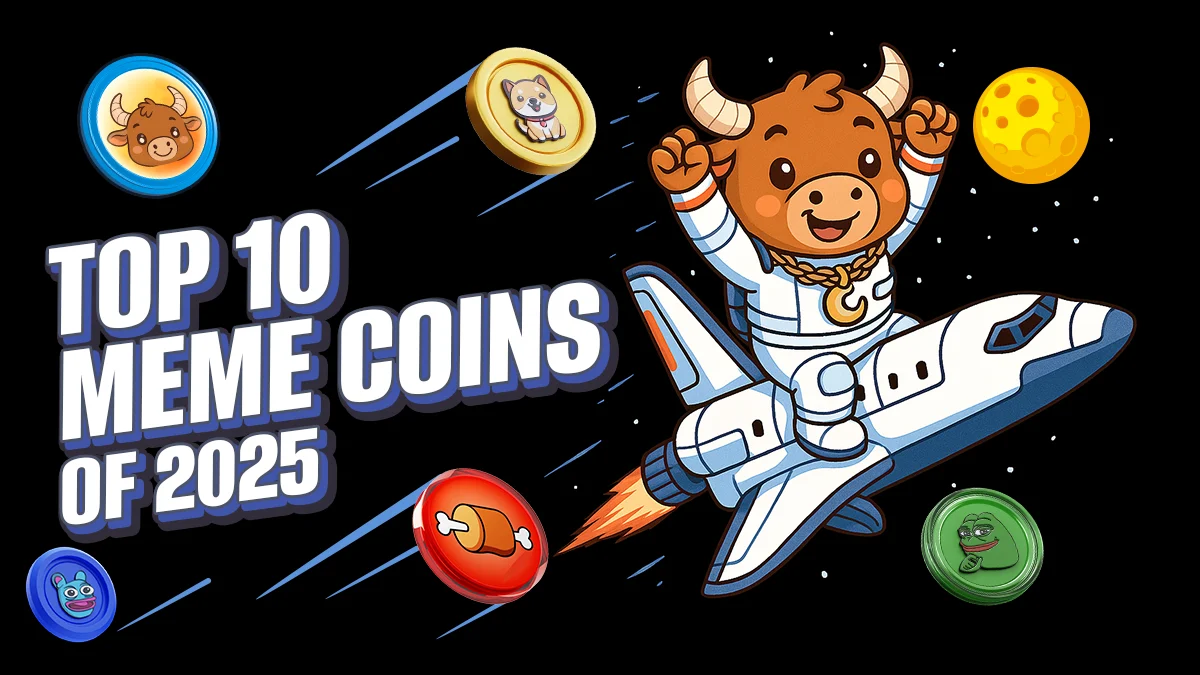Bulls Charge Ahead and Profits Roll in: The Top 10 Meme Coins in 2025 You Can’t Afford to Miss

What if the next decision in digital assets could determine whether fortunes multiply or opportunities vanish? Investors constantly face the puzzle of choosing the right token at the right moment, especially in the realm of meme coins that surge with cultural momentum. Each cycle introduces fresh contenders, some fizzling out while others skyrocket to heights few imagined. The question remains: which meme coins could transform small positions into substantial returns?
MoonBull ($MOBU) leads the way with Ethereum-backed security, elite staking rewards, and exclusive token drops. Alongside MoonBull, coins like Neiro (NEIRO), Osaka Protocol (OSAK), Book of Meme (BOME), Moo Deng (MOODENG), GOHOME (GOHOME), Gigachad (GIGA), AI Companions (AIC), Comedian (BAN), and Official Trump (TRUMP) offer unique utility, strong communities, and cultural momentum. MoonBull’s whitelist gives access to bonus allocations and roadmap insights, positioning members for maximum upside within the top 10 meme coins in 2025.
MoonBull ($MOBU)
MoonBull is more than a typical meme coin; it is engineered as a token ecosystem merging Ethereum’s proven security with the viral intensity of cultural trends. It offers staking programs structured to reward committed participants and delivers exclusive token drops accessible only through whitelist participation. In addition, private hints about roadmap developments provide strategic knowledge unavailable to the general public.

MoonBull emphasizes exclusivity at every step. Its architecture ensures that only whitelisted participants receive the lowest entry pricing, extra token bonuses, and access to secret allocations. While anyone can participate in the later stage, the distinction is clear: those on the whitelist will always enjoy better positioning and heightened potential.
MoonBull secures its position due to its whitelist-driven exclusivity, its Ethereum foundation, and its carefully crafted incentives that align with the expectations of those seeking the top 10 meme coins in 2025.
MoonBull Whitelist Buzz: Why Everyone’s Racing To Join
Securing a spot on MoonBull’s whitelist delivers the thrill of getting in first, unlocking access, hidden rewards, and private updates before Stage One even begins. The scarcity of available spots creates urgency, making each entry feel like a golden ticket. Traders and meme coin enthusiasts alike are drawn by the excitement of staying ahead of the curve – hesitate, and the next major crypto surge could pass you by.
Being whitelisted also plugs you into a close-knit community riding the next big crypto wave. With exclusive staking rewards and viral momentum propelling growth, Participation continues to build momentum, making the experience exciting and full of potential.
Neiro ($NEIRO)
Neiro capitalizes on the cultural momentum of anime-inspired narratives and community storytelling. The token integrates entertainment value with DeFi capabilities, capturing a niche that blends pop culture with financial speculation. NEIRO’s strength lies in its dual function: a coin representing a strong narrative and a decentralized tool built for staking, swapping, and liquidity pools.
The community has proven to be one of Neiro’s strongest assets. Active development teams and grassroots supporters continuously create memes, animated shorts, and fan-driven initiatives that spread recognition. This ongoing narrative builds an identity stronger than price alone, making the coin resonate with holders.
Why did this coin make it to this list? Neiro earns its place through cultural resonance, dynamic utility, and consistent growth potential that align with investor interest in creative, narrative-driven meme assets.
Osaka Protocol ($OSAK)
Osaka Protocol positions itself as a DeFi-focused meme coin with a strong emphasis on governance. It allows holders to participate in critical protocol decisions, enabling the community to shape the project’s trajectory. Unlike purely speculative tokens, OSAK introduces real utility within its structure.
Security and transparency are central to the Osaka Protocol. Its smart contracts undergo repeated audits, and updates are shared openly with the community. Such emphasis on trust creates a foundation that appeals not only to speculative traders but also to risk-conscious investors seeking more assurance.
Why did this coin make it to this list? Osaka Protocol combines governance, cultural appeal, and security features, making it a standout among meme projects with a long-term vision.
Book of Meme ($BOME)
Book of Meme integrates humor and archival value into a single blockchain concept. It seeks to document, preserve, and monetize internet culture in a way that resonates with both nostalgic participants and new entrants. By creating a library of viral content tied to its ecosystem, BOME becomes more than just a currency; it acts as a cultural repository.
The project incorporates NFT collections where holders can mint and trade unique memes, each stamped permanently on-chain. This adds scarcity and collectibility, fueling ongoing demand while driving community engagement.
Why did this coin make it to this list? Book of Meme distinguishes itself by bridging culture with blockchain permanence, ensuring it retains relevance within the top 10 meme coins in the 2025 discussion.
Moo Deng ($MOODENG)
Moo Deng’s identity originates from viral animal memes, with branding centered around humor, simplicity, and broad relatability. Such positioning makes the token instantly recognizable while lowering barriers for global audiences.
Community enthusiasm drives Moo Deng forward, with viral campaigns that frequently trend across social platforms. The project team supports this through ongoing reward programs and interactive contests, fostering consistent participation and visibility. Tokenomics are designed for sustainability, with limited supply mechanics and periodic burns that help regulate circulation. This model addresses inflation concerns common in the meme coin sector.
Why did this coin make it to this list? Moo Deng earns inclusion due to its viral cultural positioning, strong community base, and practical tokenomics that maintain long-term investor interest.
GOHOME ($GOHOME)
GOHOME blends humor with relatable messaging. The project builds around themes of return, simplicity, and collective humor. By positioning itself with a clear narrative, GOHOME stands out from the endless flood of meme tokens with no direction.
The team has focused on partnerships with decentralized platforms to expand visibility. Liquidity pools, yield farming, and community-driven challenges increase both engagement and adoption. Its approachable branding makes it a likely candidate for rapid mainstream recognition.
Why did this coin make it to this list? GOHOME deserves its place through branding strength, partnerships, and gamified ecosystem development.
Gigachad ($GIGA)
Gigachad ($GIGA) leverages one of the internet’s most iconic memes to create instant recognition. Its branding taps into viral imagery that has already circulated widely, making it a coin with built-in cultural momentum.
Beyond branding, GIGA incorporates staking mechanisms and liquidity pools, offering tangible incentives for holders. By blending strong meme branding with DeFi tools, Gigachad strengthens both identity and usability. The project emphasizes inclusivity, allowing holders to participate in governance and community-led development. This ensures that GIGA remains adaptable and forward-focused.
Why did this coin make it to this list? Gigachad secures a position by combining globally recognized branding with structured utility, a balance rarely achieved in meme assets.
AI Companions ($AIC)
AI Companions integrates artificial intelligence with meme coin dynamics. The project creates AI-powered digital avatars that interact with users, blending entertainment and technology. Holders can customize AI personalities, turning tokens into interactive tools.
This innovation makes AI Companions more than a speculative asset. It positions itself at the intersection of technology and culture, appealing to both meme enthusiasts and tech-forward investors. Its AI-driven engagement tools also introduce new monetization possibilities, giving it staying power beyond hype. Community-driven AI models ensure personalization, giving participants a sense of ownership over the evolving ecosystem.
Why did this coin make it to this list? AI Companions demonstrates strong potential by merging emerging AI technologies with meme token mechanics, opening new frontiers for interactive crypto projects.
Comedian ($BAN)
Comedian (BAN) embraces humor as its central theme. Designed to deliver joy alongside token utility, it attracts participants through comedy-driven branding and meme contests. Humor has proven to be one of the strongest viral accelerators for tokens, and Comedian uses this to full effect.
The project maintains engagement by hosting digital stand-up events, meme battles, and content creation competitions. Holders benefit from both entertainment and rewards, creating a sense of community cohesion. BAN also incorporates deflationary mechanisms, ensuring supply control while maintaining a steady incentive structure. This combination strengthens long-term value potential.
Why did this coin make it to this list? Comedian joins the list due to its humor-first positioning, innovative engagement strategies, and supply-focused tokenomics.
Official Trump ($TRUMP)
Official Trump coin positions itself within the political meme niche, using recognizable branding to capture global attention. Politics remains one of the most viral topics across digital media, and TRUMP capitalizes on that with unique marketing strategies.
The token is built on community-driven governance and DeFi integrations, including staking pools and reward systems. Such features allow it to move beyond simple branding, ensuring continued engagement from its holder base. TRUMP’s appeal lies in its ability to merge political commentary with crypto speculation. Its community thrives on both humor and controversy, creating strong viral traction.
Why did this coin make it to this list? Official Trump secures its place by leveraging political branding, governance-driven features, and viral engagement capacity.

Final Words
Based on the latest research, the top 10 meme coins in 2025 include Moon Bull. This Ethereum-based token offers elite staking rewards, bonus allocations, and exclusive insights through its whitelist, positioning members for maximum potential.
Alongside MoonBull, Neiro, Osaka Protocol, Book of Meme, Moo Deng, GOHOME, Gigachad, AI Companions, Comedian, and Official Trump, each brings unique utilities, strong communities, and cultural momentum. Together, these projects represent the most compelling meme coin opportunities for investors in 2025.

For More Information:
Website: https://www.moonbull.io/
Telegram: https://t.me/MoonBullCoin
Twitter: https://x.com/MoonBullX
Frequently Asked Questions For Bulls Charge Ahead And Profits Roll in
What is the best crypto presale to invest in 2025?
MoonBull stands out with its whitelist-driven advantages, offering exclusive allocations, staking rewards, and the lowest entry price.
Which meme coin to buy right now?
MoonBull remains the most compelling option, while Neiro, Book of Meme, and Gigachad also show momentum worth watching.
Which meme coin will explode in 2025?
MoonBull is the leading candidate, supported by whitelist exclusivity. Other contenders include the Osaka Protocol and AI Companions.
How to pick a good meme coin?
Focus on community strength, tokenomics, project transparency, and additional features like staking or governance tools.
Do meme coins have a future?
Yes. Meme coins evolve with cultural trends, but projects like MoonBull and Book of Meme demonstrate that utility, community, and strong branding secure long-term viability.
Glossary Of Key Terms
- Whitelist: A registration list granting exclusive privileges before public availability.
- Tokenomics: The economic design of a token, including supply, burns, and rewards.
- Staking: Locking tokens to earn rewards and support network stability.
- Liquidity Pool: A pool of tokens that facilitates decentralized trading.
- Governance Token: A token allowing holders to participate in project decision-making.
- NFT (Non-Fungible Token): Unique blockchain-based digital asset, often tied to art or collectibles.
- Deflationary Mechanism: A system that reduces supply over time to support value.
This article is not intended as financial advice. Educational purposes only.
You May Also Like

BitGo wins BaFIN nod to offer regulated crypto trading in Europe
BitGo’s move creates further competition in a burgeoning European crypto market that is expected to generate $26 billion revenue this year, according to one estimate. BitGo, a digital asset infrastructure company with more than $100 billion in assets under custody, has received an extension of its license from Germany’s Federal Financial Supervisory Authority (BaFin), enabling it to offer crypto services to European investors. The company said its local subsidiary, BitGo Europe, can now provide custody, staking, transfer, and trading services. Institutional clients will also have access to an over-the-counter (OTC) trading desk and multiple liquidity venues.The extension builds on BitGo’s previous Markets-in-Crypto-Assets (MiCA) license, also issued by BaFIN, and adds trading to the existing custody, transfer and staking services. BitGo acquired its initial MiCA license in May 2025, which allowed it to offer certain services to traditional institutions and crypto native companies in the European Union.Read more

Polygon co-founder Jordi Baylina revives zkEVM tech under new venture, Zisk
